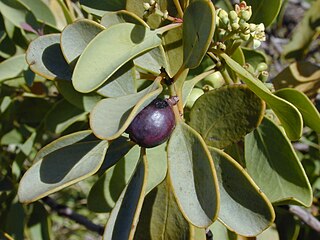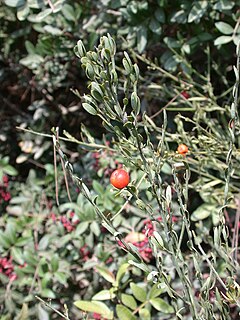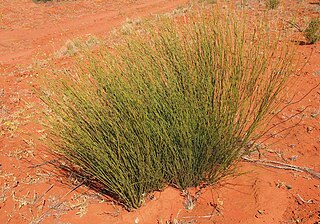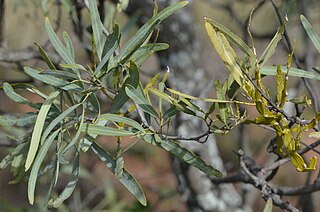
The Santalales are an order of flowering plants with a cosmopolitan distribution, but heavily concentrated in tropical and subtropical regions. It derives its name from its type genus Santalum (sandalwood). Mistletoe is the common name for a number of parasitic plants within the order.

Mistletoe is the common name for obligate hemiparasitic plants in the order Santalales. They are attached to their host tree or shrub by a structure called the haustorium, through which they extract water and nutrients from the host plant. Their parasitic lifestyle has led to some dramatic changes in their metabolism.

Viscaceae is a taxonomic family name of flowering plants. In this circumscription, the family includes the several genera of mistletoes. This family name is currently being studied and under review as in past decades, several systems of plant taxonomy recognized this family, notably the 1981 Cronquist system.

Loranthaceae, commonly known as the showy mistletoes, is a family of flowering plants. It consists of about 75 genera and 1,000 species of woody plants, many of them hemiparasites. The three terrestrial species are Nuytsia floribunda, Atkinsonia ligustrina, and Gaiadendron punctatum Loranthaceae are primarily xylem parasites, but their haustoria may sometimes tap the phloem, while Tristerix aphyllus is almost holoparasitic. For a more complete description of the Australian Loranthaceae, see Flora of Australia online., for the Malesian Loranthaceae see Flora of Malesia.

The Santalaceae, sandalwoods, are a widely distributed family of flowering plants which, like other members of Santalales, are partially parasitic on other plants. Its flowers are bisexual or, by abortion, unisexual. Modern treatments of the Santalaceae include the family Viscaceae (mistletoes), previously considered distinct.

Exocarpos is a genus of flowering shrubs and small trees in the sandalwood family, Santalaceae. They are found throughout Southeast Asia, Australia and the Pacific Islands.

Viscum is a genus of about 70–100 species of mistletoes, native to temperate and tropical regions of Europe, Africa, Asia and Australasia. Traditionally, the genus has been placed in its own family Viscaceae, but recent genetic research by the Angiosperm Phylogeny Group shows this family to be correctly placed within a larger circumscription of the sandalwood family, Santalaceae.

Schoepfiaceae is a family of flowering plants recognized in the APG III system of 2009. The family has previously only been recognized by few taxonomists; the plants in question usually being assigned to family Olacaceae and Santalaceae.

Osyris is a genus of plants in the family Santalaceae, one of the many genera known as sandalwoods, but not one of the true sandalwood. The species of this genus are mostly hemiparasitic, meaning although they can survive and grow by themselves, they also opportunistically tap into the root systems of nearby plants and parasitize them.

Pieter Willem Korthals was a Dutch botanist. Korthals was the official botanist with the Dutch East India Service from 1831 to 1836. Among his many discoveries was the medicinal plant Kratom . Korthals wrote the first monograph on the tropical pitcher plants, "Over het geslacht Nepenthes", published in 1839.

Exocarpos sparteus is an Australian endemic plant species, commonly known as the broom ballart, slender cherry, or native cherry. The species is found in all states of mainland Australia.

Santalum lanceolatum is an Australian tree of the family Santalaceae. It is commonly known as desert quandong, northern sandalwood, sandalwood, or true sandalwood and in some areas as burdardu. The mature height of this plant is variable, from 1 to 7 m. The flowers are green, white, and cream, appearing between January and October. The species has a distribution throughout central Australia, becoming scattered or unusual in more southern regions.
Santalum murrayanum, commonly known as the bitter quandong, is an Australian plant in the sandalwood family, Santalaceae. The Noongar name for the plant is coolyar.

Exocarpos latifolius is a species of parasitic trees, of the plant family Santalaceae. They have the common names broad leaved ballart, scrub sandal-wood, scrub cherry, oringorin, broad leaved cherry or native cherry. The species is found in monsoon forest, littoral rainforest and occasionally in more open forest types in Malesia and across Northern Australia.

Anthobolus is a genus of flowering shrubs in the sandalwood family, Santalaceae. The genus comprises 3 species, all endemic to Australia.
Brendan John Lepschi is an Australian botanist, whose interests include the taxonomy of the genus Melaleuca, the families Santalaceae and Goodeniaceae and how exotic species become naturalised.
Daenikera corallina is a plant parasite species in the Santalaceae family. It is endemic to New Caledonia and the only species of the genus Daenikera. Its closest relative is Amphorogyne, also endemic to New Caledonia.
Notothixos is a genus of mistletoe plant in the family Santalaceae.

Korthalsella rubra is a flowering plant in the Santalaceae (sandalwood) family, formerly placed in the Viscaceae.

Thesium humifusum is a species of hemiparasitic flowering plant in the family Santalaceae found in western Europe and north-western Africa, known as bastard-toadflax.














